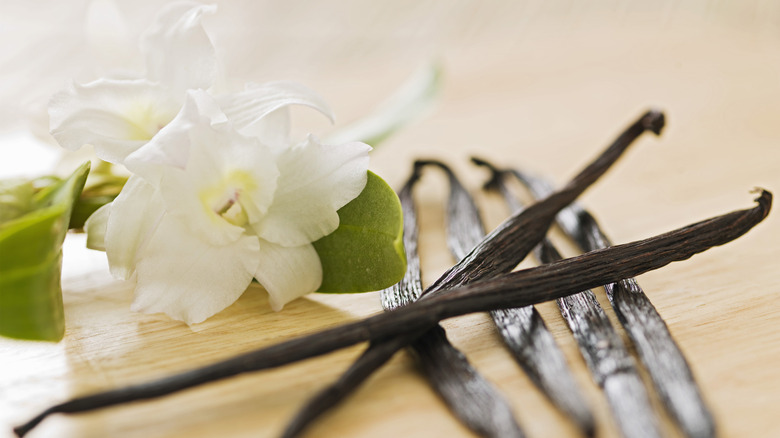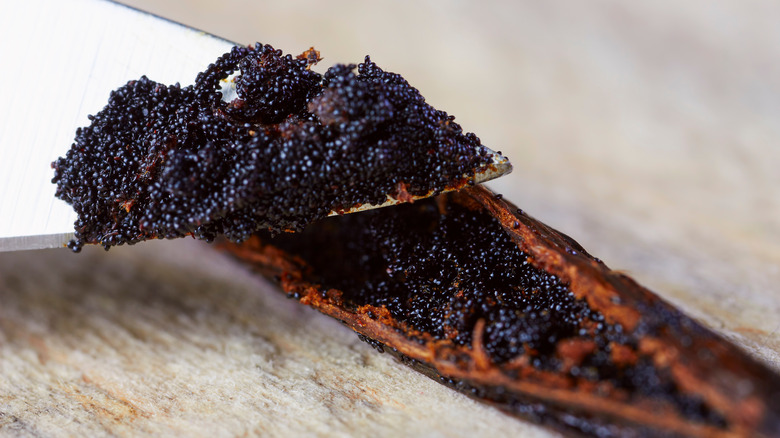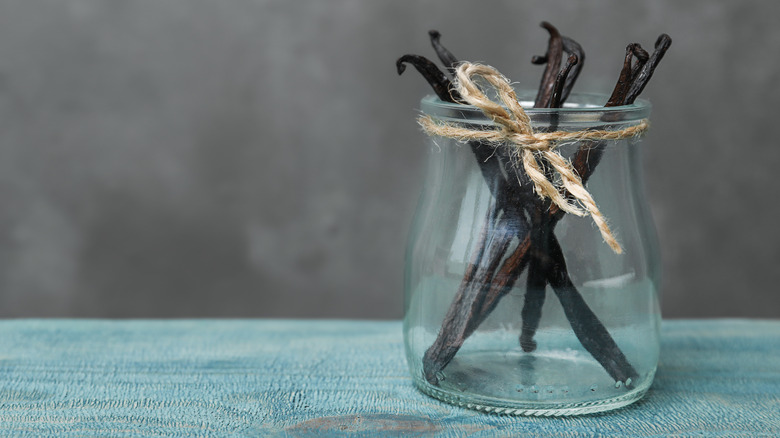What To Look For When Shopping For Vanilla Beans
Vanilla is a go-to flavoring for cakes, cookies, breads, and other baked goods. It infuses food with a wonderful fragrance and gentle yet persistent sweetness, which is a key reason why it's so beloved. When adding vanilla flavoring to a dish, many people use one of two ingredients: vanilla extract or vanilla beans. Vanilla extract is generally the more popular of the two because it's cheaper and more accessible than vanilla beans (though it's still pricey). However, vanilla beans have a more powerful taste than vanilla extract does, making it the perfect ingredient if you want to really showcase the flavors (and lovely dark speckles) of pure vanilla, per Kitchn.
What you might not know about vanilla beans is that the process of growing and harvesting them can take up to four years (via VanillaPura). According to Synergy, the vanilla orchid, which is the plant that grows the vanilla bean, only blooms one day out of the year, and if the pods are not harvested from the flowers on this day, farmers have to wait until the next year. Considering how complex it is for vanilla beans to make it to your local store — and how expensive they are when they get there — it's important that you get the best bang for your buck. Without further adieu, what should you look for when shopping for vanilla beans?
The best vanilla beans are plump, shiny, and bendable
It's best to look for vanilla beans that are "plump, with an oily sheen and...a relatively soft and pliable outer pod," per SLOFoodGroup. Vanilla beans that have these qualities are generally known as Grade A, or gourmet. Their ample shape and shine make them look beautiful, but this isn't their only benefit. According to a guide by VanillaPura, cutting and removing the seeds in Grade A vanilla beans is fairly easy due to their high moisture level, making it a smooth maneuver to coax out the goods for your baking project with the blade of a knife. So, when shopping for vanilla beans, look for thick, moist, and bendy Grade A beans, as they are the easiest to work with.
In general, you should steer clear of vanilla beans that look dry and brittle. These are referred to as Grade B vanilla beans. Unlike Grade A beans, these have a relatively low moisture content, meaning it can be more difficult to slice them open and scrape out their seeds without cracking them. However, this doesn't mean you should avoid them completely, as they perfectly good for making vanilla extract at home.
How to store vanilla beans
What should you do with your precious vanilla beans once you find them? Unfortunately, they don't have an indefinite shelf life. According to Native Vanilla, their life span ranges from six months to three years, but their quality typically declines after one year.
Though these sweet-smelling pods don't last forever, storing them properly can maximize their shelf life. The first step you should take when storing vanilla beans is wrapping them in wax paper. Next, stick them in an airtight glass container to preserve their flavor. Lastly, place the container in a cool and dark place, such as your pantry, so higher temperatures don't dry out the pods.
Interestingly, Native Vanilla reports that you should air out your vanilla beans every few weeks by opening the airtight container for a 15-minute period. This will rid the space of any excess moisture, helping the beans retain their appealing properties and stave off mold for a longer period of time.
If you follow these steps and still find that your vanilla beans are a little dry, fret not: A quick trick to boosting the flavor of vanilla bean pods is to char them over a flame, which causes them to puff and become more pliable. After that, you'll be ready to try your hand at something special, like a recipe for vanilla bean rice pudding with tart cherries.


